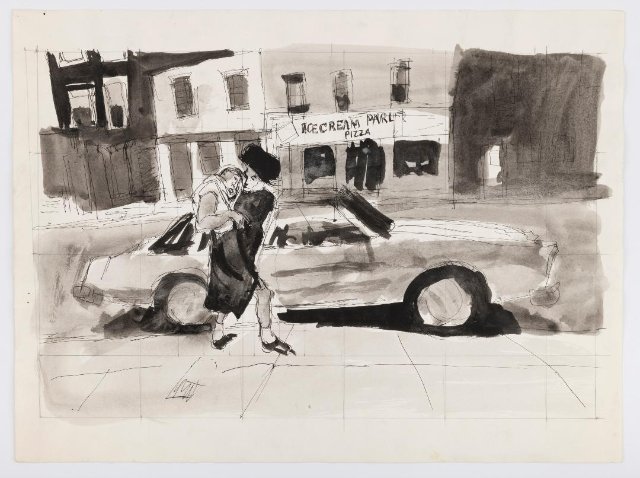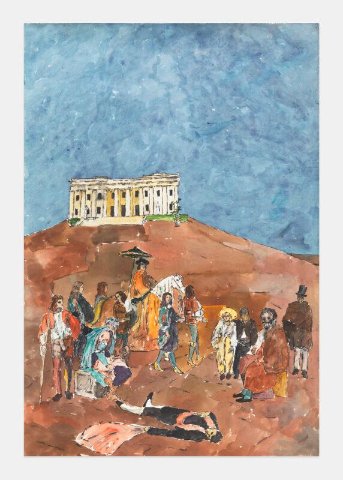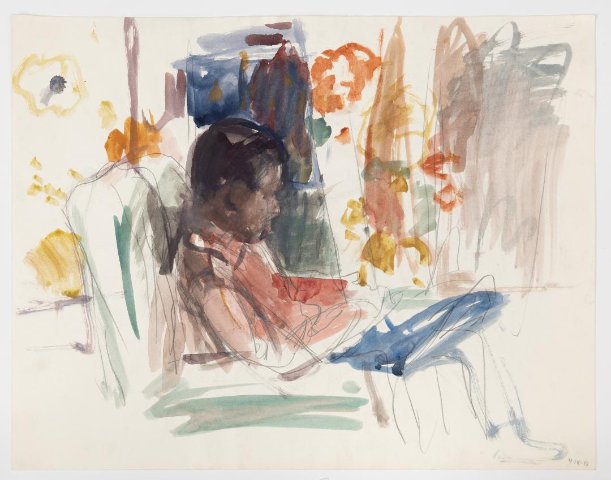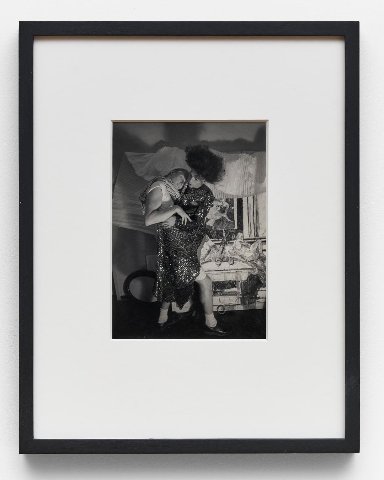Darrel Ellis and Miguel Ferrando at Candice Madey Gallery
Divergent Styles, Intertwined Lives: An Artistic Journey
By: Jessica Robinson - Aug 26, 2024
As New York’s art scene buzzes with anticipation for the fall season, mark your calendars for September 5th, when the Candice Madey Gallery, on New York’s lower East Side, will unveil a must-see exhibition.
Running through October 25th, the show, titled Darrel Ellis & Miguel Ferrando, delves into the intertwined lives and artistic journeys of two figures who were more than just friends—they were creative soulmates. Though their careers spanned only a handful of years (Ellis died of AIDS in 1992 at 34, and Ferrando in 1996, at 38 ), their work, showcased side-by-side, offers a rare glimpse into a unique artistic creative partnership from the 1980s.
Their friendship began in the halls of the High School of Fashion Industries in Chelsea, where they shared not only a drawing teacher but also a deep passion for art. Both were avid museum-goers, absorbing the vibrancy of New York’s cultural scene from a young age.
Their collective journey continued through the pre-college program at Cooper Union, where they both immersed themselves in the early 1980s art world.
While Ferrando and Ellis never became “art stars,” they were deeply woven into the fabric of New York’s downtown art scene. Ellis, a mixed-media artist who created an innovative approach to painting and photography, moved in the same circles as Robert Mapplethorpe and Peter Hujar, both of whom photographed him.
Ferrando, too, moved in the same New York downtown art scene. Being the more theatrical of the two, he also frequently performed in drag at the Pyramid Club on Avenue A.
Unlike many of their peers who found fame either during their lives, or posthumously, Ellis and Ferrando’s work stayed largely under the radar, with one exception. In 1989 Ellis had his moment in the sun: he was invited by Nan Goldin to be included in the controversial group show on the AIDS crisis, “Witnesses: Against Our Vanishing.”
The Back Story
Born in Santo Domingo in 1957, Miguel Ferrando moved to New York at the age of five, but remained deeply connected to his Dominican roots, which heavily influenced his art. His color-filled paintings often juxtaposed iconic Santo Domingo landmarks with figures inspired by such masters as Goya and Manet, thus bridging the gap between history and modern times.
Born a year later in the Bronx, Darrel Ellis carried a similarly deep connection to his heritage, though his life was marked by tragedy.
His father, Thomas Ellis, a Harlem studio photographer, was killed by police two months before his birth, leaving behind an archive of family photographs that captured the social life of Harlem and the South Bronx in the 1950s.
In his early twenties, while studying at The Whitney Independent Study Program, Ellis discovered his father’s archive, and over the next decade his father’s work became the driving force of his own artistic journey, which revolved around themes of family and identity.
In spite of their contrasting styles—Ellis with his moody black-and-white palette and Ferrando with his explosion of colors—their art was united by a shared commitment to telling stories that mattered to them. “Miguel was affected by the strong light and color of the Caribbean,” says Madey, “ and Darrel by the black and white photo body of work made by his father—his important legacy.”
Ferrando often drew inspiration from artists like Goya, Velázquez, Cezanne, and Manet, blending these historical influences with imagery of notable buildings in Santo Domingo, the city of his heritage. Two key works in this show are titled Colonialism series: My Father Likes It (Colonialism Monument: Iglesia Sagrado Corazón de Jesús, Moca, D.R.) and Untitled (Colonialism Monument: Palacio de Bellas Artes, Santo Domingo, D.R.)—feature a prone figure at the bottom, inspired by a dead matador from Manet’s famous, The Death of the Matador, as well as a Crucifixion scene.
Echoing the themes in Ferrando’s Colonialism series, in 1984 Ellis created a series with a nod to Michelangelo’s Pieta. Using Ferrando and Todd as his models, the six Pieta-themed works in this series are made up of ink-washes, drawings and posed photographs. This series, the highlight of the exhibition, is marked by an atypical exploration of allegory. Here Ellis photographed Ferrando, dressed in drag, posing as Mary, embracing his boyfriend, Todd Evan, who is depicted as a Christ figure.
In another image, Ferrando is portrayed as a woman on the street, and still another he is seen hovering over a fallen man, an unmistakable reference to both Ellis’s own father, and a nod to Manet’s “Death of the Matador.”
In yet another image, for me the most curious of them all, is Ellis’s staged photograph of Miguel wearing something on his head “that seems to be made of net material whipped up into a hat, and some slinky vintage sequined dress …and makeup,” hypothesizes photographer and keeper of the Ellis archives, Allen Frame.
While to me this photograph appears quite humorous, Frame explains it differently: “The incongruousness in the image can seem absurd or ridiculous, but in the finished Pieta series, it is more haunting or uncanny or subversive than risible.”
In addition to Ellis’ Pieta series, peppered throughout the show are portraits and still-lives in water-color by Ferrando made up of flowers and paintings of iconography with references to modern day imagery, such as airplanes.
Legacy
Shortly after Ellis’s death in 1992, a series of his photographs was featured in New Photography 8 at the Museum of Modern Art, New York; and in 1996, Frame organized a large-scale retrospective at Art in General, New York, that traveled to numerous institutions nationally
Most recently, he has been the subject of numerous exhibitions. In 2022-2024, a show titled Regeneration, toured major institutions including the Baltimore Museum of Art, the Bronx Museum, and the Milwaukee Art Museum
His work has also been featured in exhibitions at the Carpenter Center at Harvard University and Hannah Hoffman in Los Angeles in 2023. Ellis’s art is currently on display at the Metropolitan Museum of Art and the Whitney Museum of American Art in New York.
Today Ellis’s work can be found in such prestigious museums as the Art Institute of Chicago; Baltimore Museum of Art; Bronx Museum of the Arts; Brooklyn Museum; Harvard Art Museum, Cambridge, MA; Hammer Museum, Los Angeles; Los Angeles County Museum of Art; Metropolitan Museum of Art, New York; Museum of Modern Art, New York; Princeton University Art Museum, NJ; and Whitney Museum of American Art, New York, among others.
Ferrando, the lesser known of the two, has been showcased in exhibitions at the Boston Center for the Arts, Galerie Ziegler in Zurich, and Visual AIDS in New York. His work was most recently featured in Luxe, Calme, Volupté, a 2023 group exhibition at Candice Madey gallery, marking the first public display of his work since 2000.
Ferrando and Ellis’s artistic contributions are now being reexamined by institutions like Visual AIDS, as well as a new generation of scholars, who are placing their work within the broader context of 1980s and 1990s creative practices.
As the Candice Madey Gallery opens its doors to this exhibition, it’s clear that this show is not just about revisiting the past, but about understanding the profound, yet often overlooked, impact of two artists whose stories are as compelling as the art they left behind.
As Allen Frame succinctly puts it: “There’s no feeling like watching art history rewritten before your eyes.”
Darrel Ellis & Miguel Ferrando will be on view at the
Candice Madey Gallery,
1 Rivington Street, New York
September 5-October 25, 2024
Photo Credit: Kunning Huang




